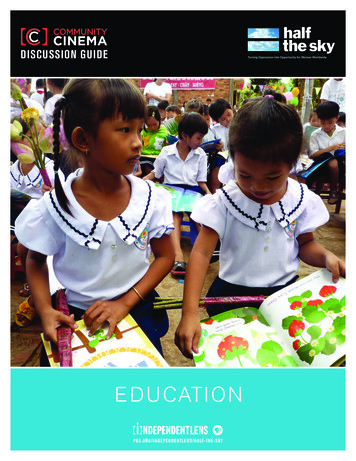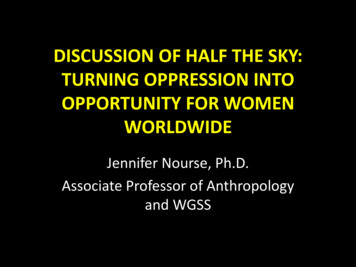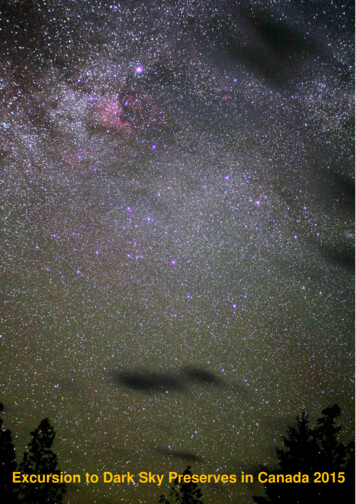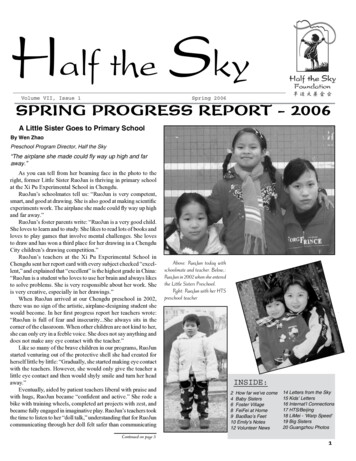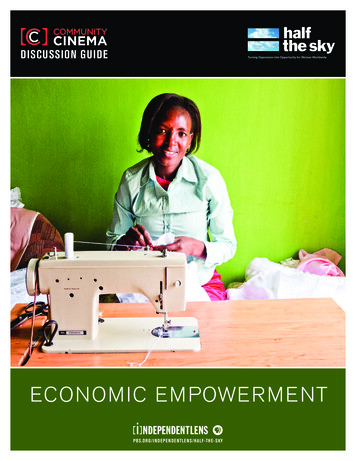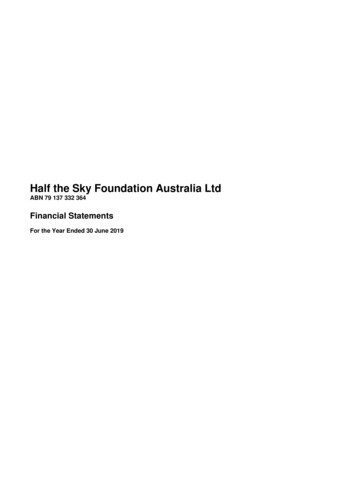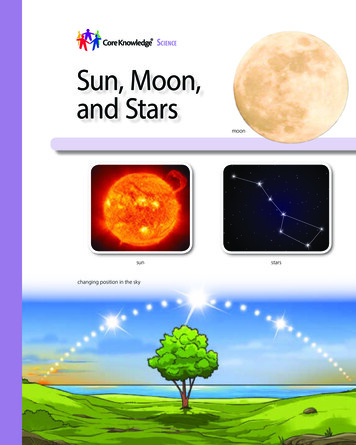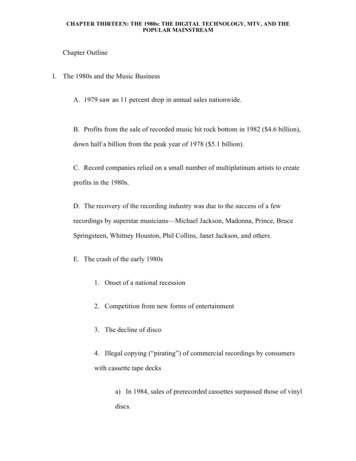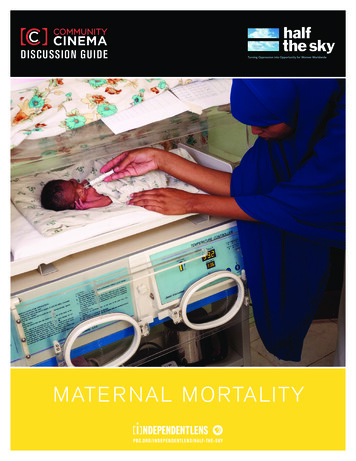
Transcription
DISCUSSION GUIDEMATE R NAL M O RTALITYPbs.org/independentlens/half-the-sky
Table of Contents1Using This Guide2–3From the Filmmaker4–6The Film5677The Film: Episode OneThe Film: Episode TwoBackground InformationEdna and Her Hospital: Maternal Mortality in Somaliland8Female Genital Mutilation9Maternal Mortality910101011121313What are Maternal Mortality and Maternal Morbidity?The Health DivideWhat are the Causes of Maternal Mortality?What is Obstetric Fistula?Why Do Women Die?The Impact of Maternal MortalityWhat's Needed to Improve Maternal Health?Maternal Mortality and the Millennium Development Goals14Thinking More Deeply15Suggestions for Action16–17ResourcesP HOTO CR E DITS: J O S H B E N N ETT, J E S S I CAC H E R MAYE F F, N I C K K R I STO F, J E N N I M O R E LLO,DAVI D S M O LE RDiscussion guide // maternal mortality2
Using This GuideCommunity Cinema is a rare public forum: a space for people to gather who are connectedby a love of stories, and a belief in their power to change the world. This discussion guideis designed as a tool to facilitate dialogue, and deepen understanding of the complexissues in Half the Sky: Turning Oppression into Opportunity for Women Worldwide. It isalso an invitation to not only sit back and enjoy the show – but to step up and take action.This guide is not meant to be a comprehensive primer on a given topic. Rather, it providesimportant context, and raises thought provoking questions to encourage viewers to thinkmore deeply. We provide suggestions for areas to explore in panel discussions, in theclassroom, in communities, and online. We also provide valuable resources, and connections to organizations on the ground that are fighting to make a difference.For information about the program, visit www.communitycinema.orgN OT E TO R E A D E R S :This discussion guide gives an overview ofthe entire two-hour Half the Sky: TurningOppression into Opportunity for WomenWorldwide film, and then provides specificbackground information and resourcesfor the country segment that deals withMaternal Mortality in Somaliland.Discussion guide // maternal mortality1
“We wanted to create aunique experience that goesbeyond “issue” filmmaking tosimply tell incredible stories”From the FilmmakerMaro ChermayeffWorking in documentary film has always been an adventure, a pleasure,and a roller coaster ride — but rarely does a project come along thatchanges one’s entire worldview.Making Half the Sky: Turning Oppression into Opportunity for Women Worldwide hastruly been a life-changing endeavor and an honor. The concept for the transmedia projectwas originally brought to me by my fellow executive producers: Jamie Gordon and MikaelaBeardsley. Mikaela had recently produced the film Reporter about the intrepid New YorkTimes columnist Nicholas Kristof. She was very excited when, in conversations in thefield, he talked about his upcoming book to be co-written with his wife Sheryl WuDunnaddressing the struggles and triumphs of women and girls in the developing world thatthey had personally encountered over years of reporting.That book turned out to be the groundbreaking work, also titled Half the Sky: TurningOppression into Opportunity for Women Worldwide, which became an internationalbestseller. The game-changing element of the book is the focus on personal stories thatallow readers to deeply connect with individual, true stories of women and girls facinghorrendous difficulty and inequity. It tackles head on issues such as maternal mortality,sex trafficking, gender-based violence, and forced prostitution — and illustrates the hopeoffered by the life-changing opportunities of education and financial empowerment. Thestorytelling nature of the subject-driven narrative leant itself beautifully to documentary film.As a New Yorker, I knew of Nick’s work as a journalist for The New York Times, and of thehighly regarded Pulitzer Prize-winning articles that Nick and Sheryl had written togetherduring their tumultuous years as reporters based in China, but I had never met eitherof them. Nick and Sheryl believe in the power of social media and the potential of thissubject matter to reach new and diverse audiences through multi-platform content. Thisis where the larger concept of the transmedia project inspired by their book came from.Now, the project is launching on multiple platforms, with a four-hour television series forPBS and international distribution through Fremantle Media; a one hour film for CommunityCinema; free curricula developed for Community Classroom, over 20 short films andeducational modules made in partnership with some of the project’s more than 54 NGOpartners worldwide; mobile games for India and Africa (executive produced with Gamesfor Change with the support of USAID); a social-action Facebook game; and two websites —one housed on PBS.org and another advocacy-based site at halftheskymovement.org.Discussion guide // maternal mortality2
From the FilmmakerAs a filmmaker, the centerpiece ofthe project for me was the documentary series. Filmed in ten countries, theseries is inspired by Nick and Sheryl’swork — but also goes beyond the page tofilm new and immediate stories that lendthemselves to the drama that televisiondemands. Our approach was to orchestrate 2-week trips to six different countries,following Nick as he reported on an agentof change working to better her own lifeor the lives of women in her community.Joining Nick on each leg of the journeywas a different actress who had experience advocating for social issues, butwho was not an expert in the specificissue we were following in that location.Rather, she was there to act as the eyesand ears of the audience, allowing an intimate and honest way into some of thesetough and demanding stories. We had thegood fortune to be joined by Eva Mendesin Sierra Leone, Meg Ryan in Cambodia,Gabrielle Union in Vietnam, Diane Lane inSomaliland, America Ferrera in India, andOlivia Wilde in Kenya.The experience of the shooting was someof the most difficult I have ever experienced in over twenty years of producingand directing large and complicatedseries. Having directed a ten-hour seriesaboard the USS Nimitz on a six-monthdeployment to Iraq (PBS, Carrier), runaway with a traveling circus (PBS, Circus),and made a film about toxic waste beingdumped on a Native American community(HBO, Mann v. Ford), I was prepared forand yet still stunned by the conditions inwhich most people in the world live. I wasespecially affected by the experiencesof women living under these conditions.From rough terrain to blistering poverty,the situations were incredibly challengingand the issues were often heartbreaking.For example, children being raped as earlyas two and three years old in post-conflictSierra Leone or the staggering reality oftrafficking and sexual slavery of younggirls in Cambodia. But the women weworked with were some of the most amazing, courageous, and admirable women Ihave ever known. The tears often flowed.Two of the more emotional experiencesoccurred while trying to help the fourteenyear-old Fulamatu seek justice againstthe uncle who raped her and two of herfriends, only to watch the case crumble,and during the harrowing brothel raid inCambodia with the fiery Somaly Mam thatfreed several under-age girls being heldin slave-like conditions where they wereforced to work as prostitutes with 10-30clients per day.Working with Nick and Sheryl was aninvaluable and amazing opportunity as adirector. I was so impressed by Nick inDiscussion guide // maternal mortalitythe field as he tenaciously sought out thestory and by Sheryl’s incredible ability tosee the big picture and address the largeglobal issues. I knew I wanted to honortheir work. We all felt from the start thatit should be an epic production, visuallystunning and visceral, showing the amazing places we visited and people we metin all their beauty. We wanted the realityof their world to be accessible and yet,at times, shocking — an edge-of-your-seatadventure with global significance. Wewanted to tell true stories, yet also deepen people’s experience and understanding of the issues women and girls face inthe developing world. We also believed,and Nick and Sheryl were deeply committed to showing, that the stories couldand should be uplifting and empowering.Even in the darkest of circumstances, wefound the most startling humanity andconfirmation of the human spirit’s resilience. People who engage with all of ourcontent — on the multiple platforms available — will be angry, motivated, inspired,and most important, feel connected to thesubjects and themes. We wanted to create a unique experience that goes beyond“issue” filmmaking to simply tell incredible stories about the capacity of humanbeings to persevere against all odds andthe restorative power of opportunity inparts of the world that are not “over-there,”but a small leap from our own backyard.3
The FilmIn 2009, Pulitzer Prize winning-journalists Nicholas Kristof and Sheryl WuDunn published a ground-breakingbook about the oppression of women and girls worldwide. That book was Half the Sky: Turning Oppressioninto Opportunity for Women Worldwide — an instant bestseller that immediately catalyzed an alreadyburgeoning movement to eradicate gender inequality.The landmark PBS documentary series Half the Sky: TurningOppression into Opportunity for Women Worldwide aims toamplify the central message of the book — that women are not theproblem, but the solution — and to bolster the broad and growingmovement for change. Using the story of the book and its impactas a launchpad, the documentary zeroes in on the lives of girls insome of the countries around the world where gender inequalityis at its most extreme and explores the very real ways in whichtheir oppression can be turned to opportunity.Featuring six celebrated American actresses and the commentaryof the world’s leading advocates for gender equality, the film is apassionate call to arms — urging us not only to bear witness to theplight of the world’s women, but also to help to decisively transform their oppression into opportunity.Episode OneGender-Based ViolenceSierra Leone Eva MendesSex TraffickingCambodia Meg RyanEducationVietnam Gabrielle UnionIntergenerational ProstitutionIndia America FerreraEconomic EmpowermentKenya Olivia WildeHalf the Sky: Turning Oppression into Opportunityfor Women Worldwide is a production of Showof Force and Fugitive Films in association withIndependent Television Service (ITVS). IndependentLens is jointly curated by ITVS and PBS and is funded by CPB with additional funding provided by PBSand the National Endowment for the Arts.Half the Sky: Turning Oppression into Opportunityfor Women Worldwide is inspired by Nick Kristofand Sheryl WuDunn’s book of the same name.Episode TwoMaternal MortalitySomaliland Diane LaneHalf the Sky: Turning Oppression intoOpportunity for Women Worldwide is aspecial presentation of Independent Lensbroadcasting on PBS October 1st and2nd, 2012.Discussion guide // maternal mortality4
The FilmEpisode OneIn Episode One we follow Nicholas Kristof and three American actresses to developing countries wheregender discrimination is at its most extreme. We explore the shocking extent of gender-based violence inSierra Leone with Eva Mendes, the global crisis of sex trafficking as experienced by women and girls inCambodia with Meg Ryan, and the need for and power of educating girls in Vietnam with Gabrielle Union,where she visits an innovative education program that is transforming, not only the lives of the country’spoorest and most vulnerable girls, but also the futures of their families and their communities. Featuringcommentary from Sheryl WuDunn and interviews with some of the world’s leading advocates for genderequality — including Hillary Clinton, Michelle Bachelet, and Gloria Steinem — Half the Sky: Turning Oppressionto Opportunity for Women Worldwide offers a nuanced and moving account of this century’s most pressingproblems, and an uplifting, actionable blueprint for change.Gender-Based ViolenceOur first stop is Sierra Leone, a countryrecovering from years of colonial oppression and a terrible civil war and which isstill suffering from rampant gender-basedviolence. Guided by Amie Kandeh, thepassionate and dedicated coordinatorof the International Rescue Committee’sWomen’s Protection and EmpowermentProgram in Sierra Leone, Kristof andactress Eva Mendes come face-to-facewith the enormous challenges women andgirls face in a country where rape is practically the norm — challenges embodiedby Fulamatu, a buoyant 14-year-old whohopes one day to become a bank manager. When we meet Fulamatu she wasraped repeatedly by a local church pastor — a family friend who is close enough tobe officially considered her uncle. She hadrisked the shame of telling her parentsand the ridicule of her community to breakher silence and press charges against theperpetrator. The outcome is a soberingobject lesson in the insidious effects ofgender-based violence, and the urgentneed to end impunity for the violators.Sex TraffickingAs interviews with WuDunn and some ofthe world’s leading advocates for genderequality explain, in many parts of the worldcultural attitudes and traditions are usedto justify the low status of girls, renderingthem vulnerable to all manner of exploitation and abuse. This is nowhere moreevident than in Cambodia, where thepernicious global problem of sex trafficking is perhaps at its worst. Actress MegRyan joins Kristof in Phnom Penh as hecatches up with Somaly Mam, one of thewomen profiled in the book Half the Sky:Turning Oppression into Opportunity forWomen Worldwide — a woman who washerself a child sex slave and who now hasdedicated her life to rescuing and rehabilitating others. As Mam’s story mergesand mingles with those of the girls in hercharge, the horrors of sex trafficking arewrit large — so too is the awesome resilience of the human spirit and the vast,untapped potential that resides in eachand every one of Mam’s girls.EducationThat potential, WuDunn and our luminaryadvocates tell us, is the key to betteringour world: tap into those girls and theywill change the future. The clarity of thatequation, the elegant cause-and-effect ofit, animates Episode One’s final sequence,in Vietnam, where former Microsoft executive John Wood’s organization Room toRead is transforming the lives of the country’s poorest and most vulnerable girls.Hosted by Bich Vu Thi, program officer ofRoom to Read’s Girl’s Education program,Kristof and actress Gabrielle Union getto know a few of the program’s stars andencounter firsthand the incredible obstacles which stand between these girlsand their bright futures. Still, these girlsare almost miraculously undaunted — andfiercely determined to change both theircircumstances and those of their families.The ripple effect of their education evennow is making itself felt — and there is nodoubt that with a little bit of help, a littleencouragement and support, these girlsand the tens of millions of others like themin the developing world will be a powerfularmy for change.Combining vivid, visceral on-the-groundstories with the commentary of a vast andimpressive roster of experts, advocates,and agents of change, Episode One takesus deep into the lives of girls in the developing world and makes us witness to theirseemingly impossible struggles — at oncechallenging and inspiring us to be a partof the vital, urgent project to empowerthem once and for all.Discussion guide // maternal mortality5
The FilmEpisode TwoEpisode Two continues our journey to the hot spots of gender oppression around the world and highlightsthe courageous work of some of the extraordinary women and men who are taking a stand in the faceof incredible odds. This episode focuses our attention on the role of women in their families and theircommunities — examining the fundamental obstacles that hinder their potential, and charting the ripple effectthat results when that potential is harnessed.Veteran journalist and Half the Sky: TurningOppression into Opportunity for WomenWorldwide co-author Nicholas Kristof isonce again accompanied by a three celebrated American actresses who offer freshand personal perspective on the issues ineach country. Kristof travels to Somalilandwith Diana Lane to examine maternalmortality and female genital mutilation,to India with America Ferrera to exploreintergenerational prostitution, and withOlivia Wilde to Kenya, where the transformative power of economic empowermentis changing women’s lives and is layingthe groundwork for the next generation. Inthe process, the film considers the centralrole of women in the health and stability oftheir families and communities and establishes their critical role in the global effortsto eradicate poverty and achieve peace.Featuring on-camera commentary fromSheryl WuDunn and some of the world’smost respected and outspoken advocatesfor gender equality — including MelanneVerveer, Zainab Salbi, and DesmondTutu Episode Two underscores the fundamental obstacles to women’s progressand prosperity and celebrates women’sboundless capacity to better our world.Maternal MortalityThe episode begins in Somaliland — anunrecognized country, populated mainlyby nomads, where the average womantoday has a 1-in-12 chance of dying inchildbirth. Joined by actress Diane Lane,Kristof reconnects with Edna Adan, founder of the Edna Adan Maternity Hospitalin Hargeisa. A spry 70-something womanoften and rightly described as a “force ofnature,” Adam is almost single-handedlyrevolutionizing the experience of childbirthin her country — providing medical care towomen who would otherwise have none,training midwives, and fighting tirelesslyagainst female genital mutilation — a traditional practice still common in much ofAfrica (and elsewhere), which severelycompromises a woman’s ability to delivera child. In Somaliland, the challengeswomen face in the developing world arestarkly apparent: Poverty and traditionconspire to undermine a woman’s health,directly threatening her life, and having alasting impact on her children’s survivaland ability to thrive.Intergenerational ProstitutionAs WuDunn and our cast of gender equality advocates argues, tradition is, in manyways, the greater evil. In too many placesin the world, tradition still is used to marginalize women, to keep them down andin their place. This vicious cycle repeatsitself generation after generation, damaging and ending lives and undermining theability of thousands of women improvetheir quality of life and live their fullpotential. The key — as Kristof and actressAmerica Ferrera discover in India — isintervention by someone from the inside:someone like Urmi Basu. A social workerand an educated, middle-class Bengali,Basu has dedicated her life to stoppingthe cycle of intergenerational prostitutionin India, where 90 percent of girls bornto sex workers follow in their mothers’footsteps. What she is up against is neatlyillustrated by one of the young girls inher care, Monisha, who is on the brink ofbeing wrenched out of school and likelysold to a brothel by her own family — afamily that belongs to a sub-caste of sexworkers. What keeps Basu going is girlslike Sushmita — and more to the point,women like Sushmita’s mother, Shoma,who has lived the utter brutality and desolation of prostitution every day of her lifeand desperately wants a different fate forDiscussion guide // maternal mortalityher daughter. Shoma’s hope for her childis the seed of real and lasting change.Economic EmpowermentWhen women have equal control overtheir finances and the financial decisionmaking on the personal, community,and national levels, everyone benefits.WuDunn and the many contributors wholent their voices and considerable expertise to Half the Sky: Turning Oppressioninto Opportunity for Women Worldwideall stress that putting money in the handsof a poor woman changes everything.During their visit to Kenya, Kristof andOlivia Wilde witness the impact of theeconomic empowerment of women firsthand. In this episode’s final segment,they explore the impact and challenges ofmicrofinance and the ways is transforming the lives of women and those aroundthem. We begin with Jane Ngoiri, a formersex worker-turned-dressmaker who is nowable to send her four children to school,where they are each at the top of theirclass, and end with Rebecca Lolosoli, aSamburu woman who built a safe havenfor women on the slender thread of a jewelry-making business. Kristof and Wildesee for themselves the dramatic andtangible transformation that can be set inmotion by a woman with a little money ofher own and a system of support to helpher make the best use of her financial andpersonal resources. Replicate the experiment several million times, and the worldwill be an entirely different place.The episode — and the film — ends withan urgent call to action, an invitation tothe viewer to take up the central moralchallenge of our time, and to join a movement that will tap the immense potentialof women to create a more peaceful andmore prosperous world for us all.6
Background InformationEdna and Her Hospital:Maternal Mortality in Somaliland“ She’s just this force of nature.”– Nicholas Kristof, Half the Sky:Turning Oppression into Opportunityfor Women WorldwideIndividuals Featured inMaternal Mortality in SomalilandNicholas KristofJournalist and Co-Author of Half the Sky:Turning Oppression into Opportunity forWomen WorldwideSheryl WuDunnJournalist and Co-Author of Half the Sky:Turning Oppression into Opportunity forWomen WorldwideDiane LaneActressEdna AdanDirector and founder of the Edna AdanMaternity Hospital in SomalilandJayne PetersVisiting Head Nurse for the Edna AdanMaternity HospitalIt is dangerous to be a pregnant woman in Somaliland.Somaliland is a semidesert territory in Africa on the coast of the Gulf of Aden thatdeclared independence from Somalia after the overthrow of Somali military dictatorin 1991. Since then, the territory has lobbied hard to win support for its claim to be asovereign state but has still not received official international recognition. Due to its status, international aid donors have found it difficult to provide support and resources toaddress widespread development needs, including the need for maternal health services.The health of the people of Somaliland is among the worst in Africa – country’s maternaland infant mortality rates are among the highest in the world. The difficulty of childbirthis compounded by various factors including lack of access to trained health professionals, high rates of malnutrition, and the prevalence of female genital mutilation, all of whichincrease the chances of complications before and during labor. While the rate of maternalmortality is among the highest in the world, it has declined from 16 deaths per 1,000 livebirths in 1997 to approximately 10 per 1,000 births in 2006, in part because of the workof Edna Adan and her hospital in the capital, Hargeisa.Adan spent over three decades working with the World Health Organization (WHO) asan adviser on maternal and child health and served as both Minister of Social Welfareand Minister of Foreign Affairs for Somaliland. After her retirement from the UnitedNations (UN), Adan used her pension and other personal assets to build the hospital inan effort to address the grave health problems that endangered the lives of women andchildren in her country.The Edna Adan Maternity Hospital in Hargeisa was established in 2002 to providequality medical services for women and children. As the first licensed nurse-midwife inher country, Adan dedicated herself not only to treating women, but also to training thenext generation of midwives, who now provide services to women in the most remoteand under-resourced areas of the country. Since its founding, the hospital has delivered over twelve thousand babies, treated over fourteen thousand patients, and trainedover seven hundred students, many of them in nursing and midwifery but also in otherdisciplines such as laboratory technology and pharmacy technology. Thanks to ongoingsupport from donors such as the U.S. charity Friends of the Edna Maternity Hospital,the United Nations Population Fund (UNFPA), and the UK Department for InternationalDevelopment (DFID), the hospital has now expanded to provide care for all members ofthe community, and is the only referral and teaching hospital in Hargeisa.Sources:»» www.ednahospital.org»» ospital.aspx»» www.bbc.co.uk/news/world-africa-14115069Discussion guide // maternal mortality7
Female Genital Mutilation“It is painful, unwanted, undesirable,uncalled for.”– Edna Adan, Founder of The Edna AdanMaternity HospitalFemale genital mutilation (also known as infibulation, female circumcision, or genitalcutting) is a complex and controversial topic – bound up in tradition, religious beliefs,and cultural identity – that has a direct effect on women and girls’ reproductive andmaternal health.Female genital mutilation (FGM) is generally performed on girls between the ages of 7 and11 as a ritual practice marking the transition to womanhood. The reasons given for practicing FGM vary among communities but it is most commonly performed to control woman’ssexuality and ensure a her virginity before and fidelity after marriage. Although FGM is notsanctioned by either Islam or Christianity, religion is often used to justify the practice.Sources:»» www.who.int/mediacentre/factsheets/fs241/en»» /fact-sheet/female-genitalcutting.cfm»» www.guttmacher.org/pubs/journals/2313097.html»» ml»» www.unfpa.org/gender/practices2.htmThe act involves the removal of part of the external female genitalia, and in its most severeform, the subject has all of her genitalia removed. The wound is then stitched together,leaving a small opening for urination, intercourse, and menstruation. The act is generallyperformed without anesthetic and is extremely painful and often traumatizing for girlswho are subjected to it with out prior knowledge and against their will. An estimated 135million girls living today have undergone FGM, with consequences ranging from infection(including HIV) to sterility, and another 2 million girls are at risk each year.Female genital mutilation can have grave consequences during childbirth. As Adan indicatesin the film, women who have undergone FGM are at higher risk for obstructed labor, aretwice as likely to die during childbirth, and are more likely to give birth to a stillborn child thanother women. The highest maternal and infant mortality rates are in FGM-practicing regions.FGM is a reflection of gender inequality and discrimination, a form of violence againstwomen and girls. Although all the countries in which FGM is practiced have legislationmaking it illegal, the complete lack of enforcement and prosecution of the perpetratorsmeans FGM continues to thrive.Although female genital mutilation is primarily performed in Africa and the Middle East itis also prevalent in immigrant communities in Europe, Australia, and the United States,despite being illegal. In 2010, in an effort to address the thousands of mutilations performed on girls in the United States every year, the American Academy of Pediatrics(AAP) made a controversial suggestion that the federal government allow physicians toperform a ceremonial pinprick or “nick” on the female child’s genitalia. This would be anominal acceptance of the family’s request for full ritual cutting and would be performedin conjunction with education regarding the immediate and long-term harms of FGM.They argued that current federal law makes any nonmedical procedure conducted onthe genitals of girls illegal, which has had the unintended consequence of driving somefamilies to take their daughters to other countries to undergo FGM. Although the goalwould be to reduce the probability that the family will take the child overseas for full cutting, many opponents of FGM have denounced the statement suggesting that a medicallysanctioned compromise such as this would legitimize the practice rather than deter it.Discussion guide // maternal mortality8
Maternal Mortality“In much of the developing world, womendon’t even have the basic right to gosee a healthcare professional.It’sdiscrimination and often it leads to death,so it’s discrimination to death.”– Sheryl WuDunn, Half the Sky:Turning Oppression into Opportunityfor Women WorldwideMaternal mortality has been identified as a global crisis and the greatest health inequity ofthe 21st century. Around the world, at least one woman dies from complications relatedto pregnancy or childbirth every minute, and 99% of these deaths occur in developingcountries — more than half in sub-Saharan Africa and almost one third in southern Asia.Of the approximately five hundred thousand women who die every year, the vast majoritysuffer from treatable conditions that become fatal due to inadequate access to medicalcare, a lack of accurate reproductive health information, and widespread gender-baseddiscrimination.What are Maternal Mortality andMaternal Morbidity?WHO defines maternal mortality as the death of a woman while pregnant or within 42days of the end of pregnancy from any cause related to or aggravated by the pregnancyor its management. For every maternal death there are approximately 30 times as manycases of pregnancy-related illness or disability, referred to collectively as maternal morbidity. An estimated 10-15 million women suffer from long-lasting conditions ranging fromdepression to organ damage and infertility, and often face social censure as a result.Sources:»» www.who.int/topics/maternal health/en»» www.un.org/millenniumgoals/maternal.shtml»» www.unfpa.org/public/mothers»» www.makewomenmatter.org»» mdgs.un.org/unsd/mdg/Data.aspx»»
That book was Half the Sky: Turning Oppression into Opportunity for Women Worldwide—an instant bestseller that immediately catalyzed an already burgeoning movement to eradicate gender inequality.

